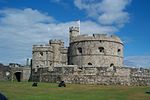Falmouth Docks
1858 establishments in the United KingdomBuildings and structures in Falmouth, CornwallDocks (maritime)Falmouth, CornwallPorts and harbours of Cornwall ... and 1 more
Use British English from December 2016

Falmouth Docks are a deep-water docks of the town of Falmouth in Cornwall, England, United Kingdom. The docks are the southern shore of the Fal Estuary which is the third largest natural harbour in the world and the deepest in Europe. They extend over 30 hectares (74 acres) and covers a range of services to shipping such as repair, refuelling, cleaning and disposal of waste services. The docks are served by the Falmouth Docks railway station. Policing is by the Falmouth Docks Police.
Excerpt from the Wikipedia article Falmouth Docks (License: CC BY-SA 3.0, Authors, Images).Falmouth Docks
Pendennis Rise,
Geographical coordinates (GPS) Address Nearby Places Show on map
Geographical coordinates (GPS)
| Latitude | Longitude |
|---|---|
| N 50.1523 ° | E -5.05566 ° |
Address
Falmouth Docks
Pendennis Rise
TR11 4LT
England, United Kingdom
Open on Google Maps







